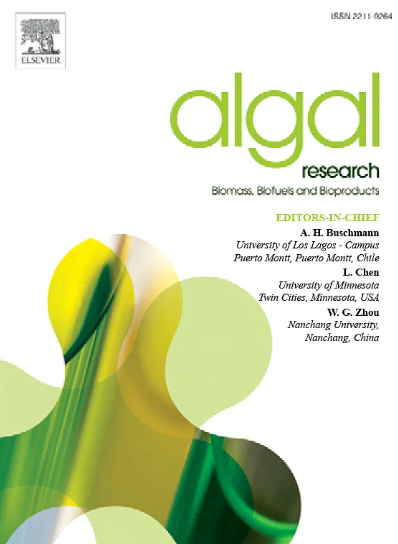澳大利亚东北部taxxiformis天冬酰胺分子和形态多样性的研究
IF 4.6
2区 生物学
Q1 BIOTECHNOLOGY & APPLIED MICROBIOLOGY
Algal Research-Biomass Biofuels and Bioproducts
Pub Date : 2025-07-02
DOI:10.1016/j.algal.2025.104182
引用次数: 0
摘要
红海藻,taxxiformasparagopsis,由多个遗传谱系组成,通过自然和人类介导的扩散在全球传播。澳大利亚和印度太平洋地区特有的A. taxformis已成为地中海等地区的入侵害虫。尽管该物种具有商业和生态重要性,但澳大利亚种群的遗传和形态多样性仍未得到充分研究。了解这种多样性,特别是在像大堡礁(GBR)这样的生物多样性热点地区,对于提高生态知识和改善保护和商业管理至关重要。本研究通过收集包括GBR海洋公园在内的昆士兰州附近和近海13个地点的四孢子虫标本,研究了澳大利亚东北部A. taxformis的遗传和形态多样性。提取标本DNA,对叶绿体RuBisCO间隔段和线粒体cox2-3基因间间隔段(cox2-3)进行测序,评估遗传多样性。测定了四孢子植物的9个形态特征。虽然使用RuBisCO间隔器发现的遗传变异很少,但cox - 2-3分析显示,谱系5 (L5)存在于两个地点,谱系6 (L6)主要存在于昆士兰南部,谱系4 (L4)普遍存在于GBR北部,这是其在澳大利亚沿海水域的首次记录。形态计量学分析发现,L4和L5在轴向细胞宽度和丝宽度上存在显著差异,这些特征被建模为区分谱系的最有用特征。研究结果强调了在澳大利亚的A. taxformis种群中存在大量的遗传和形态多样性,并且需要在代表性不足的地区进行进一步的系统采样。本文章由计算机程序翻译,如有差异,请以英文原文为准。

Insights into the molecular and morphological diversity of Asparagopsis taxiformis in north-eastern Australia
The red seaweed, Asparagopsis taxiformis, consists of multiple genetic lineages that have spread globally through natural and human-mediated dispersal. Endemic to Australia and the Indo-Pacific, A. taxiformis has become an invasive pest in regions such as the Mediterranean Sea. Despite the commercial and ecological importance of this species, the genetic and morphological diversity of Australian populations remains understudied. Understanding this diversity, particularly within biodiversity hotspots like the Great Barrier Reef (GBR), is essential for advancing ecological knowledge and improving conservation and commercial management. This study investigated the genetic and morphological diversity of A. taxiformis within north-eastern Australia, by collecting tetrasporophyte specimens from 13 near and offshore locations in Queensland, including the GBR Marine Park. DNA was extracted from specimens and the chloroplast RuBisCO spacer and mitochondrial cox2-3 intergenic spacer (cox2-3) were sequenced to assess genetic diversity. Nine morphological characteristics of the tetrasporophyte were also measured. While little genetic variation was found using the RuBisCO spacer, cox2-3 analysis revealed that lineage 5 (L5) was present at two locations, lineage 6 (L6) dominated southern Queensland and lineage 4 (L4) was prevalent in the northern GBR, marking its first record in Australian coastal waters. Morphometric analyses identified significant differences in axial cell width and filament width among L4 and L5, with these traits modelled to be most useful for differentiating between lineages. The findings highlight substantial genetic and morphological diversity within A. taxiformis populations of Australia and the need for further systematic sampling in underrepresented locations.
求助全文
通过发布文献求助,成功后即可免费获取论文全文。
去求助
来源期刊

Algal Research-Biomass Biofuels and Bioproducts
BIOTECHNOLOGY & APPLIED MICROBIOLOGY-
CiteScore
9.40
自引率
7.80%
发文量
332
期刊介绍:
Algal Research is an international phycology journal covering all areas of emerging technologies in algae biology, biomass production, cultivation, harvesting, extraction, bioproducts, biorefinery, engineering, and econometrics. Algae is defined to include cyanobacteria, microalgae, and protists and symbionts of interest in biotechnology. The journal publishes original research and reviews for the following scope: algal biology, including but not exclusive to: phylogeny, biodiversity, molecular traits, metabolic regulation, and genetic engineering, algal cultivation, e.g. phototrophic systems, heterotrophic systems, and mixotrophic systems, algal harvesting and extraction systems, biotechnology to convert algal biomass and components into biofuels and bioproducts, e.g., nutraceuticals, pharmaceuticals, animal feed, plastics, etc. algal products and their economic assessment
 求助内容:
求助内容: 应助结果提醒方式:
应助结果提醒方式:


